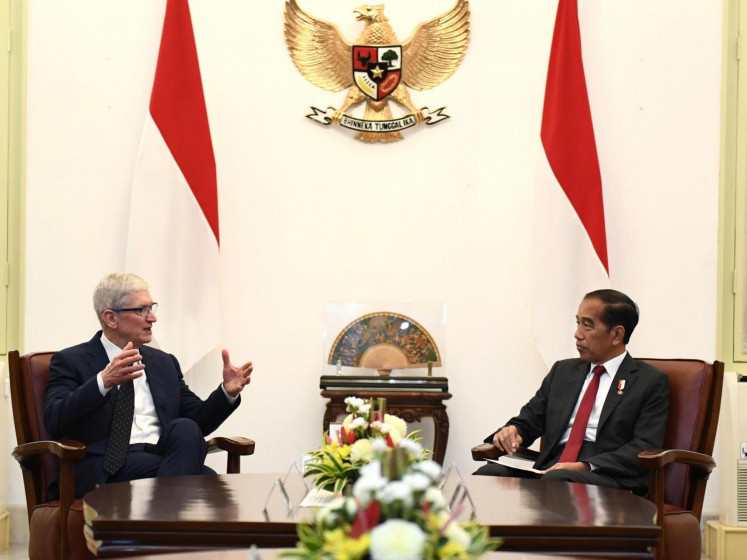View Point: White Paper, weapons procurement and national sovereignty
There was a significant event in security and defense-related affairs in late May when the country’s new Defense White Paper was released
Change Size

There was a significant event in security and defense-related affairs in late May when the country’s new Defense White Paper was released. Initially due in 2013-2014, its release was delayed because of the change in administration from the government of Susilo Bambang Yudhoyono to the current one of Joko “Jokowi” Widodo, and also due to a number of consultations for improvement and adjustment.
In essence, the latest White Paper does not offer much to differentiate it from its predecessor. However, in general it offers a comprehensive view of the country’s grand vision of defense as it incorporates various issues and dynamics.
One significant aspect that it highlights is that Indonesia’s defense power development is not intended to promote an arms race, but is instead aimed at achieving the goal of establishing the nation as a significant maritime power. The vision is more or less the same as — and perhaps strengthens — the previous government’s objective of achieving the Minimum Essential Force (MEF) in its weaponry system. The only apparent difference is that unlike the 2008 version that focused on territorial defense, the new Defense White Paper incorporates the global maritime axis and state defense concepts to deal with potential threats over the next five years.
The release of the White Paper came at the height of a series of international visits of Defense Minister Ryamizard Ryacudu to several weapons producing countries, including South Korea in late March, Russia in late April and the US in mid-May, as well as a meeting with his Chinese counterpart Chang Wanquan on the sidelines of the 10th ASEAN Defense Ministers Meeting in Vientiane, Laos, late last month. Those visits and meetings were mostly meant to enhance bilateral defense cooperation with the respective countries, but apparently were also used by Ryamizard to inspect military weapons and equipment produced by them.
In South Korea, the minister took a close look at the construction of the KFX/IFX jet fighter and diesel-powered DSME209 submarine, which had been part of the Indonesia-South Korea strategic cooperation agreement on their joint development and production. In the US, Ryamizard held meetings with key military figures and the defense secretary to discuss a number of defense/military cooperation issues.
In Russia, Ryamizard met with his Russian counterpart Sergei Shoigu and Industry and Trade Minister Denis Manturov, to discuss a number of issues on defense/military cooperation. The most high-profile item on the agenda of his Russian visit, however, was probing the possibility of procuring Russian-made SU-35 Super-Flanker. Not to be overshadowed from the discussions was the possibility of also procuring Russian naval diesel-electric Varshavyanka Class (Improved Kilo Class) attack submarines.
Meanwhile, the agenda of his meeting with Chang Wanquan in Vientiane was to sign an Indonesia-China bilateral military cooperation agreement.
In short, Ryamizard’s overseas trips have been made in close association with the MEF policy and global maritime axis target as outlined in the Defense White Paper.
One key aspect of Indonesia’s defense system that needs urgent action is the protection of the country’s sea and air territories from border violations by foreign military ships and aircraft. Such a concern cannot be separated from the last three incidents involving Chinese fishing vessels — and Coast Guard ships — and Indonesia’s Navy and Maritime Affairs and Fisheries Ministry patrol boats over alleged border violations by the former. Those incidents exclude other cases of border violations by both fishing vessels and military ships of other countries, some of which apparently went unreported.
Similar incidents also have happened in the air, with many violations in Indonesia’s vast territory also going unreported.
To address the problems of border violations by foreign ships and aircraft, there is no other option than to improve the country’s defense system technologically. Part of the government’s decision is correct, with the focus on improving the country’s weaponry system at sea and in the air, because these are two areas of defense that urgently need improvement.
Although it does not mean that our land defense system does need improvement as well, the only major consideration is the urgency of improving the country’s naval and air defense capacity and capability. Priority should therefore be given to the improvement of our naval and air defense systems.
There is one area of defense that has likely been forgotten or at least has received less attention from the government – the stationary defense system, precisely its radar and missile system. While the ongoing and planned procurement of jetfighters and submarines — as the standard, modern era defense/military weaponry to at least meet the country’s MEF target in 2024, and concurrently comply with the President’s Global Maritime Fulcrum policy — is of high importance, no less significant is the improvement of defense radar and missile systems – with a priority put on the concern for compatibility of the systems with the weapons in use as well.
It is worth noting that the nation’s radar system must be able to identify its own various types of jet fighters to ensure it does not consider some of them “enemy aircraft” just because those specific types of jet fighters are not included in the radars’ installed system.
In relation to the country’s limited financial capacity, the choice of weapons procured must also take into account long-term strategy and the age of the weapons so that once they arrive, they do not turn out to be outdated and useless due to a lack of technological competitiveness.
__________________
The writer is a staff writer at The Jakarta Post.









